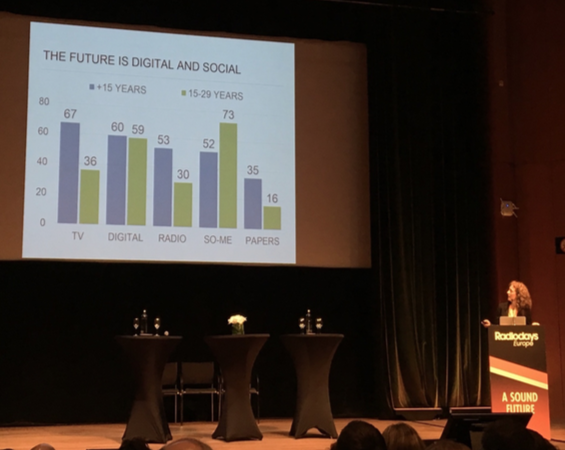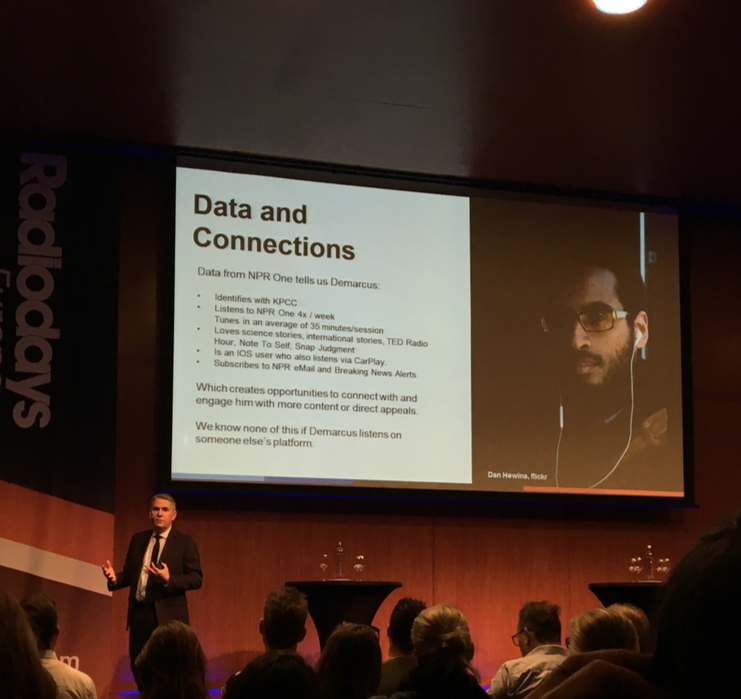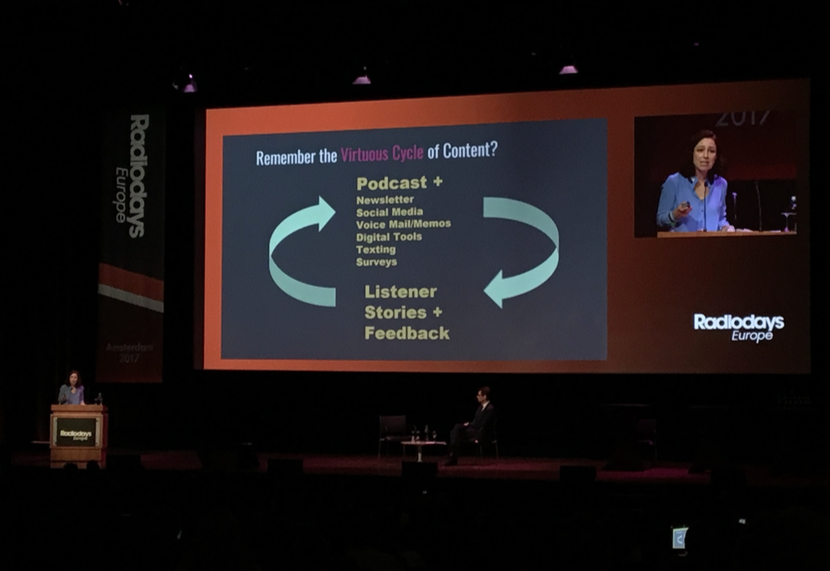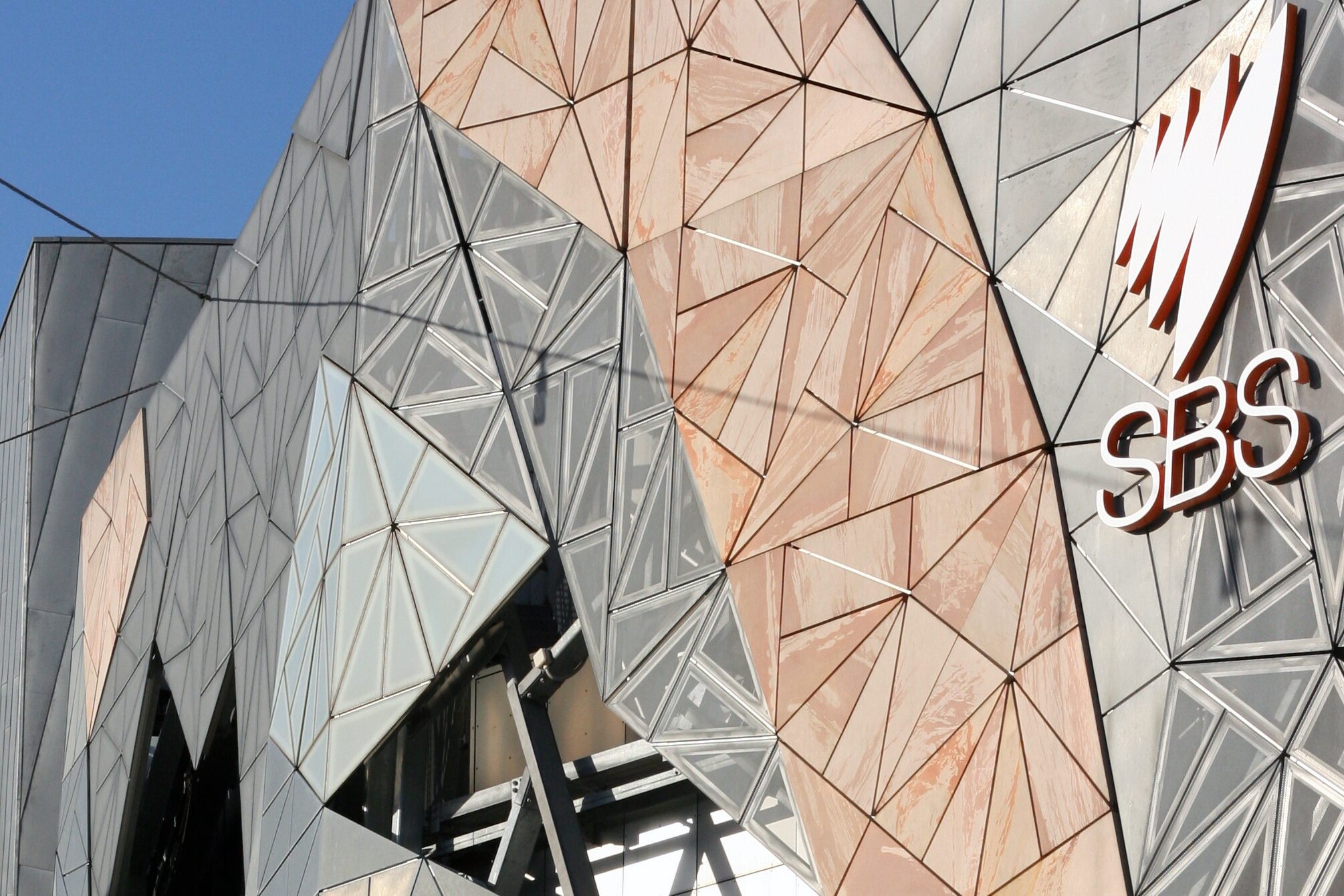From data analysis to chatbots and podcasts, this year’s Radiodays Europe conference in Amsterdam brought together the latest radio tools, tech and content from commercial and public media organisations.
With 60 exhibitors, 120 speakers and 55 sessions, the 3-day long conference (19-21 March) paid homage to the power of radio while also looking to its future.
Indeed, times are changing for traditional broadcasters who increasingly need to adapt to keep pace with more digitally savvy and fragmented audiences as well as greater competition and meeting the challenges of “fake news” and “alternative facts”.
Yet many of the speakers were optimistic about facing these challenges and offered examples as to how they’re adapting their stations for the future. The need to embrace, invest and train in new technology was obviously widely discussed, yet many speakers also emphasised the need for collaboration, both with other stations and by involving and working with audiences to produce content.
For this week’s Best of PSM, we’ve decided to highlight some of the sessions, content and tools demonstrated at RadioDays that gave us hope for the future and ongoing relevance of this most accessible of media platforms.
“The Future of news is already here”

Naja Nielsen, Head of News for the Danish Broadcasting Corporation (DR), gave a rousing talk on Journalism in the Digital Era, one of the first sessions of the conference.
Despite the popularity of news, Naja highlighted the struggles of keeping pace with other stations and the audience, and how going “multi-platform” was the only way to secure the future of radio and reach younger audiences.
Despite the dominance of DR in the Danish radio landscape only 30% of 15-29 year-olds use radio as their “frequent source of news” compared to 36% for TV and a huge 73% for social media. In fact DR’s dominance is, according to Nielsen, predominantly due to the limited choice available on the FM spectrum.
Mobile and digital transition therefore pose serious challenges to DR in terms of competition, particularly with the rise of social media and the ability for anyone to publish content. The lack of transparency associated with social media is of particular concern to Nielsen and her team, who no longer feel as if they are “editors in chief” in this landscape preferred by the under 30s.
The solution? DR’s Head of News is pushing for greater collaboration and development, producing “real journalism by real journalists”. The key, she says, is not to be afraid of promoting this and adapting news for those that are no longer “passive receivers”, or for those that “bite back” and require inclusivity.
DR is therefore investing in a number of apps to better distribute and curate content for younger audiences, including a cross border collaboration with Norway’s NRK to develop a radio app similar to that of BBC’s iPlayer. They are also developing a chatbot that will use a “public service algorithm” that users can interact with to bring the most relevant news to their attention.
For more information about Denmark’s changing media landscape, check out DR’s Media Development 2016 report that offers a comprehensive overview of emerging media use patterns amongst its audience.
Big Data for Radio
NPR’s Senior Director of Digital Products, Joel Sucherman, used his session to describe how NPR are keeping pace with their audience and maintaining interest through the use of data – a perfect follow on to the overview presented by Nielsen. In fact, NPR’s ratings are at an all time high at a time when many news organisations have been forced to contract.
This is partly due to NPR’s successful transition into a multi-platform broadcaster, producing a broad range of digital content and podcasts. The latter have proven particularly successful, with NPR seeing a 46% increase in its audience over the past year, with over 4million podcast listeners each week. There has also been a surge in NPR.org users with an average growth of 28% per month.
Yet its not simply a case of becoming multi-platform that has allowed NPR to attract more audiences, it’s also thanks to the swathes of data that digital content can gather to offer insights into audience behaviour and interests, including when and for how long content is being listened to.

Sucherman explained that by interpreting this data, NPR producers are able to adapt content to ensure greater audience loyalty. For example, data collected from the NPR Politics Podcast showed that listeners were leaving after 60 seconds due to the length of the introduction. When the intro was scrapped, subscription numbers started to rise.
But the data isn’t just that collected automatically, it is also transactional. The NPR One app is designed to connect users to a stream of public radio news and other content that is curated for them. It relies on algorithms based on what users listen to most and what they “like” by clicking on a lightbulb icon or sharing via social media.
The resulting data collected not only allows the app to curate content based on the user’s interests but also allows producers to profile their audience, informing them what is and isn’t liked, in turn giving users greater input into the production and curation of content.
NPR One therefore gives the broadcaster a means to engage with and learn from its audience in a way that wasn’t possible with analogue technology. This has proved particularly useful for feedback on pilots and new shows while also proving incredibly popular with younger, more actively engaged audiences – 60% of NPR One listeners are under the age of 44.
Engaging with audiences
Using data to understand what your audience wants is one way of producing engaging content, the other is to offer a platform that directly includes them. RadioDays offered sessions from two producers who did just that: NRK’s Håkon Moslet and WNYC’s Manoush Zomorodi.
Manoush is host and managing editor of WNYC’s “Note to Self” podcast. Titled “Extreme Engagement”, Manoush’s brilliant session demonstrated her experimentation with interactive storytelling, crowdsourcing and data collection to build a loyal and enthusiastic audience, taking them on introspective journeys about the impact of personal technology on everyday life. The aim of her shows are to provide value to and involve the community as a whole.
In 2015 Manoush launched the “Bored to Brilliant” podcast campaign about society’s over reliance on side glances to their smartphones during times of potential boredom. This, according to research, could be incredibly bad for our creative output. Manoush therefore asked her listeners to monitor their smartphone habits and initiated an online campaign with email alerts that were designed to inspire creativity, offer challenges or request people simply “space out” rather than resorting to their phones. The podcast was accompanied by two apps that monitored phone use.

According to Manoush up to 20,000 people signed up to the project across 20 countries, with 70% reporting they had reduced the time spent on their smartphone by the end of the series. This success inspired follow-up projects, including Infomagical that addressed issues surrounding information overload and Privacy Paradox, a show aimed at cutting through the mist surrounding “terms of service” notifications.
Each project is complimented by a number of “Note to Self” shows that listeners are encouraged to contribute to with audio feedback from their participation in the project. This “virtuous cycle of contact” or “feedback loop” with listeners is considered essential for maintaining the show’s relevance by allowing the audience to feel that they can directly contribute to the show.
The feedback loop is also essential for Moslet’s Shame, making it the global cult phenomenon it is today. Premiered in 2015, the webcast drama follows a group of teenagers as they come of age with storylines that aren’t afraid of negotiating sensitive and sometimes controversial topics. Indeed the original aim of Shame, according to Moslet, was to help teenagers “strengthen their self-esteem through dismantling taboos, making them aware of interpersonal mechanisms, and showing them the benefits of confronting their fears”.
Yet beyond the frank and open storylines, Shame has also made headlines for its successful embrace of social media to influence how the show is produced. Using a combination of surveys, school and youth club visits, interviews, Instagram, Snapchat and other social media, producers use feedback from the audience to direct the course of the show – meaning that the script can change while production is taking place.
This integrated multi-platform broadcast also allows producers to engage audiences outside of allotted broadcast slots and publish clips of characters in “real-time”, with each character having their own social media accounts. A bedroom scene, for example, would be published later in the evening on Instagram, with comments acting as both a source of content and a useful source of advertising as the content is shared amongst users.
Infact, Shame has never had an orthodox promotion strategy, with no preliminary TV marketing. It relies on viewers to build the hype as clips are shared online ahead of the series launch.
For Moslet, Shame has been an unparalleled success, combining contemporary social issues and multi-platform services to garner a loyal following, both from Norwegian teenagers and the wider public – even the Norwegian police and Prime Minister have asked teenagers to watch Shame and learn.
Embracing change, innovation and collaboration
These sessions clearly demonstrated the steps public broadcasters are taking to embrace change, innovate and collaborate to maintain their relevance, and they were not alone. From the innovative use of virtual reality storytelling by Canada’s CBC to a public-private collaborative approach to digital transition in Norway, RadioDays 2017 reinforced the message that radio (and television) in the digital age was far more than a top down, linear medium that can – with the right motivation – adapt to the contemporary media landscape and the preferences of younger audiences.


